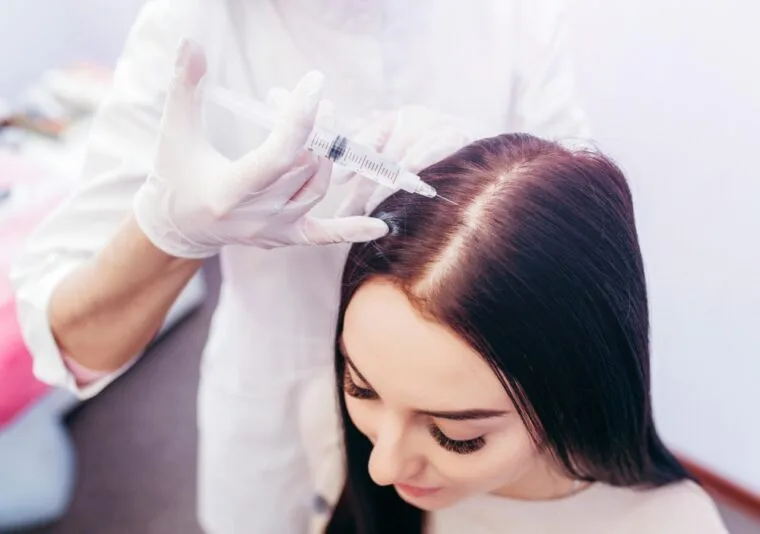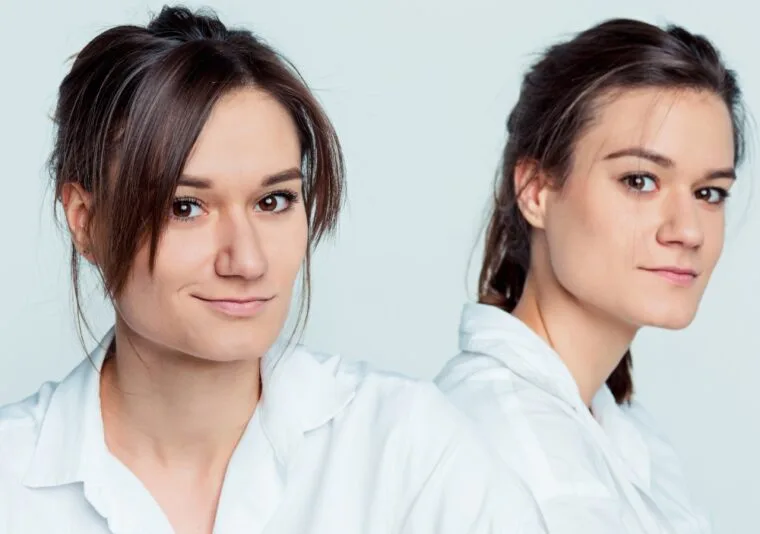Contents
- PRP Stimulates Dormant Hair Follicles
- Mesotherapy Nourishes and Strengthens Hair Follicles
- Synergistic Effect for Maximized Hair Regrowth
- PRP and Mesotherapy for Men
- PRP and Mesotherapy for Women
- FDA-Approved, Safe, and Effective
- Non-Surgical with Minimal Downtime
- Customized Consultations
- Lifestyle-Specific Approach for Optimal Results

The Classic Combo – PRP + Mesotherapy for Men & Women
Hair loss is a common concern for both men and women, affecting self-esteem and confidence. For many, treatments like PRP (Platelet-Rich Plasma) and mesotherapy offer promising, non-surgical solutions to combat thinning hair and promote regrowth. PRP harnesses the power of a patient’s own blood to stimulate dormant hair follicles, while mesotherapy nourishes and strengthens the scalp with essential nutrients. Together, these treatments create a synergistic effect that maximizes hair restoration, addressing both the underlying causes of hair loss and the nourishment needed for healthy growth. This article explores how PRP and mesotherapy work for both men and women, their FDA-approved safety, minimal downtime, and the customized approach that ensures optimal results tailored to individual needs.
PRP Stimulates Dormant Hair Follicles

PRP (Platelet-Rich Plasma) is a natural treatment that utilizes a patient’s own blood to enhance hair regrowth. During the procedure, a small sample of blood is drawn from the patient, which is then processed in a centrifuge to separate the platelet-rich plasma from other components. This plasma is packed with growth factors and healing properties that are crucial for regenerating hair follicles.
Once injected into the scalp, PRP stimulates the dormant or weakened hair follicles by increasing blood flow to the scalp. This enhanced circulation delivers more oxygen and essential nutrients to the hair follicles, which, in turn, jumpstarts the hair growth process. The growth factors in PRP also encourage the production of new cells and collagen in the scalp, promoting thicker, healthier hair growth. This treatment is particularly beneficial for patients experiencing early-stage hair thinning, as it can restore the natural growth cycle of the follicles, leading to noticeable improvements in hair thickness and density.
PRP can also reduce inflammation and improve scalp health, making it an ideal treatment for individuals dealing with scalp conditions like dandruff or seborrheic dermatitis that may be hindering hair growth.
Mesotherapy Nourishes and Strengthens Hair Follicles

Mesotherapy complements PRP by directly nourishing and hydrating the hair follicles through a series of micro-injections that deliver a carefully selected cocktail of vitamins, minerals, amino acids, peptides, and other nutrients. These injections are targeted directly into the scalp at the sites where hair thinning or loss is most pronounced, ensuring that the follicles receive optimal nourishment.
By providing a steady supply of the right nutrients, mesotherapy helps to restore the health of the hair follicles, strengthen weak strands, and prevent further hair loss. Some of the essential components of mesotherapy include biotin, vitamins B5 and B12, hyaluronic acid, and other antioxidants that help maintain the hair’s vitality and strength. These nutrients not only improve the overall health of the follicles but also support the growth of new hair.
Mesotherapy also helps prevent the miniaturization of hair follicles, which is a common issue for individuals with androgenetic alopecia (pattern baldness). It can be used in combination with PRP to optimize hair growth outcomes, particularly in areas of the scalp that may not respond well to one treatment alone.
Synergistic Effect for Maximized Hair Regrowth

The combination of PRP and mesotherapy creates a powerful synergistic effect that addresses both the stimulation of hair follicles and the nourishment they need for healthy growth. While PRP initiates the regeneration of hair follicles by promoting circulation and cellular activity, mesotherapy ensures that these newly activated follicles receive the essential nutrients required for optimal performance.
PRP serves as the catalyst for hair regrowth, while mesotherapy works to maintain follicle health and protect against further hair loss. This dual-action approach significantly enhances the chances of regrowth and improves the overall quality of hair, making it thicker, stronger, and longer-lasting. For individuals with more advanced hair loss, combining these two treatments can make a substantial difference, as it not only promotes hair growth but also strengthens existing hair strands.
This synergistic effect ensures that both the mechanical stimulation of hair follicles and the biological nourishment of the scalp are maximized, leading to more consistent and noticeable improvements.
PRP and Mesotherapy for Men: Targeting Male Pattern Baldness

In men, PRP and mesotherapy are highly effective for treating male pattern baldness (androgenetic alopecia), a condition that affects a significant percentage of men as they age. This form of hair loss is primarily driven by genetic factors and the presence of dihydrotestosterone (DHT), which causes hair follicles to shrink and eventually stop producing hair.
PRP helps combat this by increasing blood flow to the scalp, revitalizing dormant follicles, and stimulating the growth of thicker, more robust hair. At the same time, mesotherapy works to replenish the nutrients and vitamins that may be lacking in the scalp, further supporting healthy hair growth. Together, these treatments target the specific areas where hair thinning is most noticeable, such as the crown and receding hairlines, and help to restore a fuller, more youthful appearance.
For men experiencing early to moderate stages of hair loss, this combination therapy can delay further thinning and even reverse some of the damage caused by DHT, leading to a more sustainable, long-term solution for hair restoration.
PRP and Mesotherapy for Women: Addressing Diffuse Thinning and Hormonal Changes

Women often experience hair thinning due to a range of factors, including hormonal fluctuations (especially during pregnancy, menopause, or periods of stress), nutritional deficiencies, or chronic conditions like polycystic ovary syndrome (PCOS). Unlike male pattern baldness, hair loss in women tends to be more diffuse, affecting the overall volume and density of the hair, rather than leading to distinct bald spots or receding hairlines.
PRP and mesotherapy work together to address these unique challenges by promoting regrowth in thinning areas and replenishing the nutrients necessary to restore hair volume. PRP encourages healthy hair follicle regeneration, while mesotherapy nourishes the scalp and strengthens individual hair strands. These treatments are particularly effective for women who are experiencing thinning along the part, temples, or crown, where the hair may become noticeably sparser.
Furthermore, the treatments can help to balance hormone levels that are contributing to hair loss, ensuring that the hair growth cycle is restored to its optimal state.
FDA-Approved, Safe, and Effective

Both PRP and mesotherapy are FDA-approved procedures, which means they have been rigorously tested for safety and efficacy. The FDA approval process ensures that these treatments meet the highest standards of care, minimizing risks and maximizing potential benefits. PRP, in particular, is a highly safe and natural procedure, as it uses the patient’s own blood, eliminating the risk of allergic reactions or immune system rejection.
Mesotherapy, too, involves the use of well-researched, FDA-approved substances that are known to benefit hair follicles. The combination of both treatments ensures that patients receive a cutting-edge, medically approved solution to their hair loss concerns.
Non-Surgical with Minimal Downtime

PRP and mesotherapy are non-invasive, non-surgical procedures, meaning there are no cuts or stitches involved. Patients undergoing these treatments typically experience very little discomfort, and there is no need for anesthesia. Since there is no downtime or significant recovery period, most patients can return to their normal activities within 24 to 48 hours after the procedure.
Unlike hair transplants or other surgical interventions, which may require weeks of recovery, PRP and mesotherapy allow individuals to enjoy the benefits of hair restoration with minimal interruption to their daily lives.
Customized Consultations Based on Hair Type

One of the most significant advantages of PRP and mesotherapy is their ability to be customized to each patient’s unique hair type and concerns. During the initial consultation, a specialist will evaluate your scalp and hair condition, considering factors like hair texture, thickness, density, and any underlying medical conditions or lifestyle factors that may be contributing to hair loss.
For example, individuals with fine hair or early-stage hair thinning may benefit from a different formulation of mesotherapy nutrients compared to those with more advanced hair loss. By customizing the treatment plan to the patient’s specific needs, doctors can ensure that both PRP and mesotherapy are as effective as possible.
Lifestyle-Specific Approach for Optimal Results

In addition to customizing the treatment to individual hair types, the consultation process also considers the patient’s lifestyle. Factors such as diet, stress levels, sleep patterns, and hair care habits can all play a role in the success of the treatment. For instance, someone with a high-stress job may need additional support for stress management alongside their hair restoration treatment, as stress can exacerbate hair loss.
Moreover, the specialist may suggest changes in diet or hair care routines to complement the treatments and help enhance results. For example, incorporating more nutrient-rich foods or specific supplements may further boost the health of the scalp and hair.



